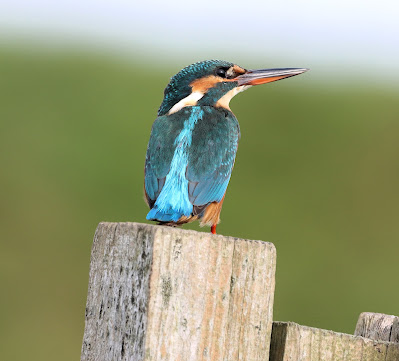On Tuesday morning Will and I met up to have a go for Linnets and anything else in the offing.
Firstly I stopped off along the A585 main road and checked on the small group of Mute Swans, a couple of Whooper Swans and egrets that have spent a number of days on a single field.
Two days before I saw two small, crouching white egrets that upon closer views were Cattle Egrets and not the usual Little Egrets that frequent these fields. There was Little Egret too, picking through the recently cleared crop of maize.
Our catching was extremely quiet even though there seemed to be lots of birds on the move in the way of 30+ Skylark, 15+ Pied Wagtail, 30 Greenfinch, 3 Great-spotted Woodpecker, 8 Redwing, 10 Reed Bunting, 8/10 Tree Sparrow, 12 Chaffinch and a dozen or more Meadow Pipit.
So many birds around attracted the usual raptors looking for a meal with single sightings of Merlin, Sparrowhawk and a fine “cream head” Marsh Harrier.
Linnets came and went in their usual frustrating fashion, dipping in and out of the target area without staying long enough to be caught. The number of parties noted added up to 150+, therefore a catch of just two proved how difficult it can be to catch Linnets in any numbers when the species is so wary and flighty. Hardly surprising considering the attention their flocks receive from raptors looking for a snack.
A Chaffinch and two Linnets was the sum of effort however both Linnets proved to be of the “Scottish” type, our eyes now well trained to pick out them out in a crowd. Look at the example below, a female with a very dark, almost black streaked cap with equally dark grey ear coverts and general dark streaked appearance.
Unexpected came two new Cetti’s Warbler that we were able to age and sex as both birds of the year, one male and one female. With wing and weights of 62mm and 15.3 gms; 56mm and 10.8 gms, the two displayed no overlap, unlike Cetti’s Warblers that remain unsexed in the winter months when biometrics fit into both camps, male or female.
Cetti’s Warbler first appeared in this area known as the Fylde in the early 1990s at Marton Mere, Blackpool. There then followed a series of sightings of single birds and ones or two through the 1990s and into the new millennium whereby the species became well established but never numerous in a small number of mainly coastal or near coastal wetland localities.
The species remains very difficult, almost impossible to see in the field, often the only clue to its presence the rattling burst of loud song that emanates from a patch of unkempt scrubby growth or reeds adjacent to water.
Stay tuned folks for my look at a stunning new bird book sure to appeal to birders, everywhere, here in UK and for sure the United States.
Terns of North America by Cameron Cox
I have a copy of Terns of North America. A Photographic Guide. Coming soon on Another Bird Blog. This one you will definitely want.































.JPG)














.jpeg)































